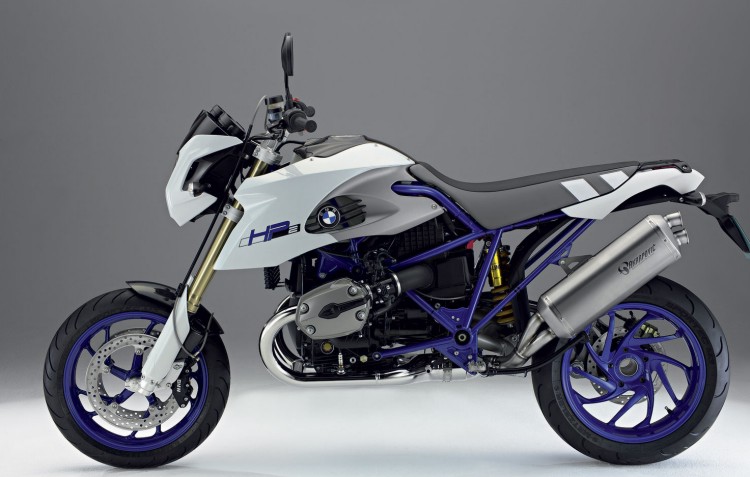
|
|
|
|
|
|
Classic Bikes
Custom Bikes
Individual
Racing Bikes AJP
AJS
Aprilia
Ariel
Avinton / Wakan
Bajaj
Benelli
Beta
Bimota
BMW
Brough Superior
BRP Cam-Am
BSA
Buell / EBR
Bultaco
Cagiva
Campagna
CCM
CF Moto
Combat Motors
Derbi
Deus
Ducati
Excelsior
GASGAS
Ghezzi Brian
Gilera
GIMA
Harley Davidson
Hero
Highland
Honda
Horex
Husaberg
Husqvarna
Hyosung
Indian
Jawa
Kawasaki
KTM
KYMCO
Laverda
Lazareth
Magni
Maico
Mash
Matchless
Mondial
Moto Guzzi
Moto Morini
MV Agusta
MZ / MuZ
NCR
Norton
NSU
Paton
Peugeot
Piaggio
Revival Cycles
Roland Sands
Royal Enfield
Sachs
Sherco
Sunbeam
Suzuki
SWM
SYM
Triumph
TVS
Ural
Velocette
Vespa
Victory
Vincent
VOR
Voxan
Vyrus
Walt Siegl
Walz
Wrenchmonkees
Wunderlich
XTR / Radical
Yamaha
Zero
Video
Technical
Complete Manufacturer List
|
BMW HP2 Megamoto
Primal scream therapy. On the track or the street, there's never been a supermoto like the awesome new HP2 Megamoto. The street version of the monster HP2 Enduro, the Megamoto is armed with tons of power in the form of a 113 hp Boxer motor that spits out 85 lb-ft of torque. Every extra detail has been stripped away to create a a supermoto machine offering thrilling, out of this world excitement in every gear. With a dry weight of just 393 lbs, low center of gravity, inverted Marzocchi forks, Öhlins rear shock, and plenty of wheel travel in both front and rear suspensions, the HP 2 Megamoto's enjoys sharp, supremely responsive handling. An Akrpovic exhaust adds efficiency, while Brembo brakes assure maximum stopping power.
On a supermoto machine with this much raw performance,
one thing is for sure: those corners don't stand a chance.  Review The three most-sold vehicle models on the
road today are pickup trucks and SUVs, so it would stand to reason that American
motorcyclists would demand a similar motorcycle, one that combines manly,
intimidating styling and off-road practicality with a simple, powerful motor
that is noisy and pisses off environmentalists. You'd think, but in fact they
buy cruisers and sportbikes, machines with as much off-road capability as a
microwave oven.
BMW's F650 family is somewhat lighter and
more nimble than the R-GS series. They're fun little bikes, and they come
closest to the spirit of those simple, early R80GSs, but with a liquid-cooled
single-cylinder motor and chain (or belt) drive, the "Funduro" may be fun, but
not really the same thing.
Sounds great, doesn't it? However, BMW
doesn't seem to like making motorcycles exactly the way people want, and if they
do want them, they come with a steep price tag. The HP-2 has a stratospheric 36
inch-high seat, is being made in small quantities, and some of you louts out
there might think $19,990 is a lot to pay for a dirtbike, even if it is built to
120% scale. Because of these minuses, we had no plans to test one.
Stomping down on the shifter easily slips the
six-speed gearbox into first and the clutch has a light pull. I give it a bit
too much gas with the handlebars turned, and the bike lurches forwards, the rear
Metzler Karoo2 full knobbie slipping slightly on the slick concrete of the fleet
center's parking lot. I pretend to not notice and tear off down the driveway.
Another novel feature is the rear air
suspension. I always viewed air-adjustable suspensions as non-functional
gimmickry, but the EVO unit on the HP-2, jointly developed by Continental
Automotive Systems and BMW, works. The rear end absorbed the bumps as well as a
spring-equipped one could, without overheating or feeling mushy. It also has an
added plus of easy adjustability; a small bicycle pump is clipped to the frame
for your convenience. The BMW's strong brakes
coupled with a vague front end mean I'm destined to spend a good
portion of the day sliding the front into berms or changing my
shorts in the pits. However, its excellent air shock means the
back of the bike was well behaved and steering was easily
controlled with the throttle. This really shouldn't be a
surprise; how else would you turn a 90hp dirt bike?
|
|
|
Any corrections or more information on these motorcycles will be kindly appreciated. |